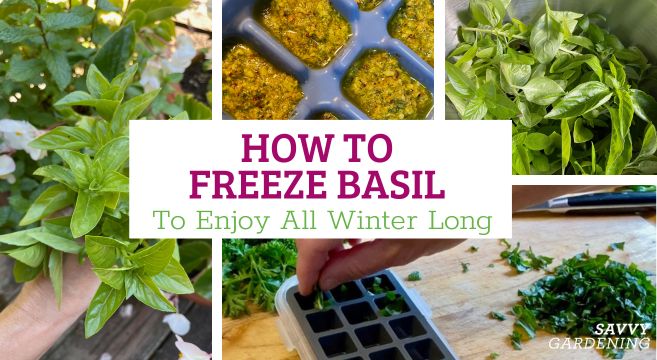This post may contain affiliate links. If you make a purchase through links on our site, we may earn a commission.
Basil is one of my favorite summer herbs, but I find it painful to have to buy basil to use in winter recipes when I grow it all summer. That’s why I freeze fresh herbs, so I can enjoy that fresh flavor if I don’t have an indoor herb plant at hand for my recipe. In this article, I’m going to share advice on how to freeze basil a few different ways.
Frozen basil can be used in a variety of different recipes, from pasta dishes, soups, and stews, to stir fries and casseroles.
Before getting started, check out our helpful archive of articles that talk about basil varieties to try, basil-growing tips, and troubleshooting basil problems.

Preparing basil to freeze
When you bring your basil indoors, give it a good rinse to remove any insects or soil. I find my salad spinner works well to wring out any excess water. Otherwise, you can use a colander and lay the basil out on half a clean tea towel. Fold the other side over to pat dry. Or, use a paper towel.

Before freezing leaves, you may want to remove them from the stems. I find some columnar basil stems to be a bit woody, so I painstakingly pull off all the leaves that I’m going to use when I’m harvesting from that type of variety.
You can also chop your leaves to make them smaller, depending on their size. Mammoth basil, for example, has very big leaves. The chiffonade technique involves stacking leaves and then slicing them with a sharp knife to form thin strips.

How to freeze basil into cubes
One of the easiest ways to preserve basil leaves is to freeze them into ice cube trays. You can use plastic or silicone trays. Pack the leaves into each cube and then slowly fill them with cold water. If you want them in pieces, finely slice them, as mentioned above, or use the food processor to chop them up a bit. Once the cubes are frozen, pop them out and put them in a labeled freezer bag.
If I’m heating up tomato sauce in the winter, I’ll pop a couple of frozen basil cubes in and allow them to just melt right into the sauce. And if I’m short on basil cubes, I’ll toss in a pesto cube or two.

You can also freeze fresh basil into olive oil instead of water. Instead of water, slowly drizzle olive oil into your tray to cover the basil.
Do you need to blanch basil?
I’ve had success freezing basil leaves in water, without having to blanch it. Blanching does help the basil leaves retain their color, however it can diminish their flavor. For this process, I would leave your basil leaves whole and still attached to some stems. Before you boil your water, prepare a bowl of ice water filled with ice cubes. Lay a clean, dry tea towel on the counter with another close at hand.
To blanch your herbs, boil a pot of water. When it’s ready, take a pair of tongs or a ladle strainer and dip your basil into the boiling water for about three to five seconds. You want to avoid cooking the leaves completely. Immediately afterwards, dunk the leaves into your ice bath for a few seconds. Remove them and place the leaves onto your tea towel. Use the other to pat the leaves dry.

Stack the leaves or roll them up and put them in a freezer bag, making sure you squeeze the air out as you go. Seal the bag and slide it into the freezer.
How to freeze basil pesto
Another great way to preserve and freeze basil is to make pesto. You can use your thawed pesto ice cubes to flavor pasta sauces or stews, to coat pasta or veggies, or to spread onto a sandwich or wrap. Pesto has a few extra ingredients than simply basil leaves. It’s a blend of olive oil, salt, pine nuts (I use sunflower seeds), garlic, and Parmesan. If you’re freezing your pesto, leave the Parmesan cheese out as it doesn’t freeze as well. Here’s an example of a pesto recipe, but there are tons of similar ones to choose from.
When my garlic scapes are ready, I will also make garlic scape pesto the same way, but I will add some of my fresh basil leaves from the garden to cut the garlic flavor a bit.

Once you’ve made your pesto, freeze it into ice cube trays. Once frozen, pop them all out (if you need your trays for other things) and store in freezer bags. Then, when you need pesto, you can simply take as many cubes as you need for your recipe and thaw them out to use. At this point you can stir in the Parmesan cheese that you had left out of the recipe in order to freeze.
You can also freeze full servings in freezer bags, press them flat and stack in the freezer. I’ve seen someone refer to this as a “frozen meal library.” This helps to save space.
More tips for preserving the harvest
In the middle of winter, I love being able to pull any of my preserved harvest out of the freezer or the pantry to enjoy those fresh flavors of summer. And I’ll dream about what I can plant and preserve the following growing season.




Leave a Reply